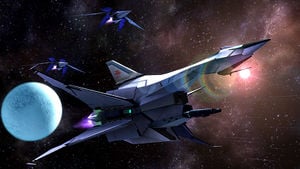Orbital Gate Assault
| Orbital Gate Assault | |
|---|---|
 File:StarFoxSymbol.png | |
| Universe | Star Fox |
| Appears in | SSB4 (Wii U) |
| Availability | Starter |
| Crate type | Futuristic |
| Tracks available | Theme from Area 6 / Missile Slipstream Star Wolf's Theme / Sector Z Corneria Main Theme (Star Fox 64) Area 6 Space Battleground Break: Through the Ice Star Wolf (Star Fox: Assault) Bolded tracks must be unlocked |
| Article on Lylat Wiki | Beltino Orbital Gate |
Orbital Gate Assault (オービタルゲート周域, Orbital Gate Area) is a stage in Super Smash Bros. for Wii U based on Star Fox: Assault. It is partially set aboard the Great Fox, as with the previous Star Fox stages Sector Z, Corneria, and Venom. There are also sections set on top of missiles and on Arwings. It was confirmed as a stage on October 1, 2014, although a Pic of the Day teased it more than two months prior. It was revealed to have conversations similar to Smash Taunts in the Super Smash Bros. for Wii U: 50 Fact Extravaganza.
In order for the conversations to appear, neither Fox and Falco should be in the match. When the stage is selected, all players need to hold down a button or two.
- Wii U GamePad: ZL/ZR
- Nunchuk: Z
- Wii U Pro Controller: ZL/ZR
- GameCube Controller: Z
- Nintendo 3DS: L
Origin
This stage is based on the eighth story mission in Star Fox: Assault. This mission sees the parasitic Aparoid race mount a direct attack on the Star Fox team's homeworld, Corneria, in a last-ditch attempt to prevent the deployment of an Aparoid-eradicating virus. In an Arwing-only battle within the planet's orbit, the team works with rival unit Star Wolf along with the Cornerian Defense Force to repel the Aparoid forces and destroy several missiles targeting the space station on which the virus is being developed.
Gallery
Trivia
References
|
| |
|---|---|
| Fighters | Fox (SSB · SSBM · SSBB · SSB4 · SSBU) · Falco (SSBM · SSBB · SSB4 · SSBU) · Wolf (SSBB · SSBU) |
| Assist Trophies | Andross · Krystal |
| Stages | Sector Z · Corneria · Venom · Lylat Cruise · Orbital Gate Assault |
| Items | Smart Bomb |
| Other | Leon Powalski · Panther Caroso · Peppy Hare · ROB 64 · Slippy Toad |
| Vehicles | Arwing · Great Fox · Landmaster · Wolfen |
| Trophies, Stickers, and Spirits | Trophies (SSBM · SSBB · SSB4) · Stickers · Spirits |
| Music | Brawl · SSB4 · Ultimate |
| Masterpiece | Star Fox 64 |







